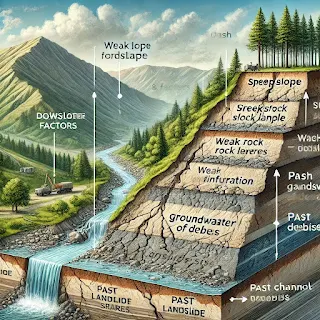Landslides occur when the driving forces (gravity, water saturation, seismic activity) exceed the resisting forces (cohesion, friction, vegetation cover) on a slope. To understand landslide dynamics, we classify contributing factors into:
- Upslope Factors – Conditions on the upper part of the slope that contribute to instability.
- Downslope Factors – Conditions at the base that further exacerbate landslides, often by removing support or altering water flow.
1. Upslope Factors
(a) Steep Slope Angle (Gradient Effect)
- A higher slope gradient increases shear stress, making the slope more susceptible to failure.
- Angle of Repose: The maximum angle at which a material remains stable; exceeding this angle leads to landslides.
- Example: The Himalayan region has high landslide risks due to steep slopes and tectonic activity.
(b) Weak Soil or Rock Type
- Lithology (rock type) determines slope strength.
- Clay-rich soils (e.g., montmorillonite) expand when wet, reducing stability.
- Weathered rocks (e.g., shale, phyllite) lose cohesion over time.
- Example: Western Ghats experience landslides in lateritic soils after monsoon rains.
(c) Vegetation Cover
- Roots reinforce soil and absorb excess water.
- Deforestation increases erosion and runoff.
- Example: Amazon Basin has stable slopes due to dense tree cover, while Haiti suffers from deforestation-induced landslides.
(d) Water Saturation (Pore Water Pressure Effect)
- Hydrostatic pressure increases soil weight and reduces internal friction.
- Infiltration capacity varies; sandy soils drain better than clayey soils.
- Example: Uttarakhand floods (2013) triggered landslides due to excessive rainfall.
(e) Joints and Fissures
- Geological discontinuities (faults, bedding planes, joints) act as failure planes.
- Example: The San Andreas Fault in California increases landslide risks due to active tectonics.
(f) Human Disturbances
- Construction (roads, dams) alters load distribution.
- Mining induces vibrations and weakens slopes.
- Example: The Malin landslide (Maharashtra, India, 2014) was worsened by hill cutting for agriculture.
2. Downslope Factors
(a) Erosion at the Base
- Undercutting by rivers, waves, or glaciers removes slope support.
- Example: Konkan coast, India experiences coastal landslides due to wave erosion.
(b) Changes in Water Table
- High groundwater levels increase pore pressure and reduce cohesion.
- Example: Oso landslide (Washington, USA, 2014) was linked to high water table changes.
(c) Steep Channel Gradients
- Accelerated water flow scours the base, destabilizing the slope.
- Example: Teesta River valley, Sikkim has landslide-prone zones due to steep stream gradients.
(d) Presence of Debris
- Accumulated sediments create barriers, leading to sudden failures.
- Example: Landslide dams in Nepal Himalayas cause flash floods when breached.
(e) Previous Landslide Activity
- Remobilization of old debris increases future risks.
- Example: Darjeeling region experiences recurring landslides due to historical instability.
- Interplay Between Factors: Upslope and downslope factors often act together.
- Mitigation Strategies:
- Upslope: Reforestation, slope drainage, terracing.
- Downslope: Retaining walls, river training, landslide barriers.
- GIS-Based Risk Mapping: Combining remote sensing and Digital Elevation Models (DEM) helps in hazard prediction.

Comments
Post a Comment